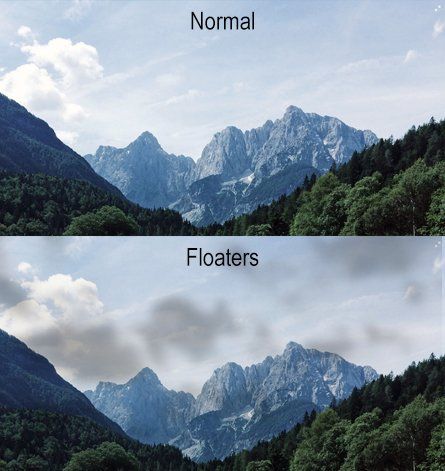Call Today! (419) 521-3937 (EYES) or Toll Free: (888) 549-3937 (EYES) | Find Us
Eye Floaters
What is Degenerative Vitreous Syndrome?
What is LFT?
About LFT

How does LFT Work?
LFT involves the application of nanosecond pulses of laser light to evaporate the vitreous opacities and to sever the vitreous strands. During this process, the floater's collagen and hyaluronin molecules are converted into a gas. The end result is that the floater is removed and/or reduced in size

What happens during the procedure?
LFT is performed as an outpatient procedure; you do not have to stay overnight in a hospital. Immediately prior to treatment, your ophthalmologist will administer eye drops to provide mild anesthesia. A contact lens will then be placed on your eye, with the laser light delivered through a specially designed microscope.
During treatment, you will likely observe small, dark specks/shadows - signaling that the floaters are being evaporated into small gas bubbles. These gas bubbles quickly dissolve and resorb into the vitreous.
Once the treatment is complete, your ophthalmologist may treat your eyes with anti-inflammatory drops.
Each treatment session typically takes 20-60 minutes to perform and most patients will need to undergo two treatment sessions, sometimes three, in order to achieve a satisfactory result.

Who can benefit from LFT?
It is necessary to undergo an ophthalmic examination to determine your eligibility for treatment with LFT.
Onset of Symptoms: if your floater symptoms develop very quickly then they may be caused by PVD, which can be treated with LFT.
Floater Characteristics: large floaters with a soft border, situated away from the retina, are ideally suited to treatment with LFT.

What to expect after treatment.
You may observe small, dark specks in your lower field of vision immediately following treatment, but these small gas bubbles will quickly dissolve. It is also important to note that some patients may experience mild discomfort, redness or temporarily blurred vision directly following treatment.
Reported side effects and complications associated with LFT are rare. Side effects may include cataract and intraocular pressure (IOP) spike.
Clinical studies have shown LFT to be a safe, effective treatment in the majority of patients. If floaters persist, however, your ophthalmologist may recommend surgery.
Discovery LFT & See More Clearly!
Contact Us Today!
Contact Us
We will get back to you as soon as possible.
Please try again later.
Sat-Sun: Closed
© 2019 Advanced Eye Care & Surgery Center. All Rights Reserved.


